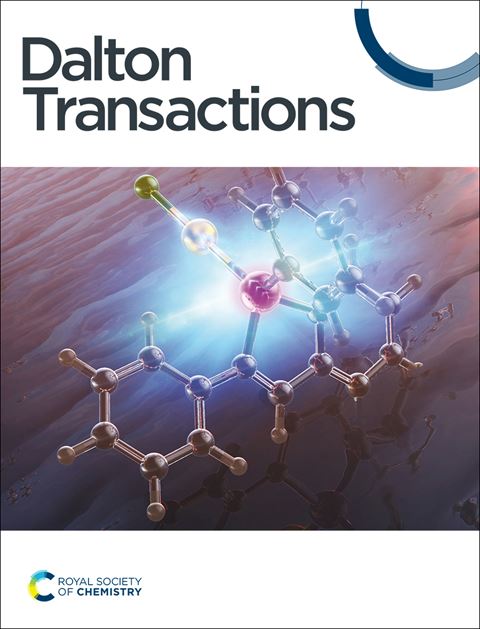一种具有双传感特性的新型发光EuBTC@HA复合材料。
IF 3.5
3区 化学
Q2 CHEMISTRY, INORGANIC & NUCLEAR
引用次数: 0
摘要
本研究旨在提出一种基于EuBTC@HA体系(H3BTC = 1,3,5-苯三羧酸,HA代表羟基磷灰石)的新型复合材料,用于双传感Fe3+离子和氧氟沙星。这是支持在(生物)载体上的Eu(III)基配位聚合物的第一个例子。Fe3+离子可以在1.00 × 10-2 ~ 7.80 × 10-5 M的较宽浓度范围内选择性检测,在7.50 × 10-3 M的浓度下猝灭。因此,最大限度地使用活性形式的EuBTC,在EuBTC@HA中用量最少,可以在保持活性的同时降低金属浓度(31.7 wt%对13.6 wt% Eu)。此外,对EuBTC@HA的可重复使用性进行了测定,表明它可以至少使用5次来检测Fe3+离子,而发射强度没有明显变化。此外,使用EuBTC@HA可以在pH范围为4.5-8.8的缓冲液中检测Fe3+离子。EuBTC@HA的附加功能通过检测浓度为3.90 × 10-5 M的氧氟沙星并产生肉眼变色效果的能力得到证实。最后,研究了Fe3+离子和氧氟沙星的荧光猝灭机理。本文章由计算机程序翻译,如有差异,请以英文原文为准。
A novel luminescent EuBTC@HA composite with dual sensing properties.
This study aims to present a new composite material based on the EuBTC@HA system (where H3BTC = 1,3,5-benzenetricarboxylic acid and HA stands for hydroxyapatite) for dual sensing of Fe3+ ions and ofloxacin. It is the first example of a Eu(III)-based coordination polymer supported on a (bio)carrier. Selective detection of Fe3+ ions was possible in a wide concentration range of 1.00 × 10-2 M down to 7.80 × 10-5 M, with quenching at a concentration of 7.50 × 10-3 M. An analogous study was performed for EuBTC, showing comparable photoluminescence activity. Therefore, the maximum use of the active form of EuBTC with its minimal amount in EuBTC@HA allowed the reduction of metal concentration (31.7 vs. 13.6 wt% Eu) while maintaining activity. In addition, the reusability of EuBTC@HA was determined, showing that it may be used at least five times for the detection of Fe3+ ions without a significant change in emission intensity. Furthermore, using EuBTC@HA allows for the detection of Fe3+ ions in buffers within the pH range of 4.5-8.8. The additional functionality of EuBTC@HA was confirmed by the ability to detect ofloxacin at a concentration of 3.90 × 10-5 M with a naked-eye colour change effect. Finally, the fluorescence quenching mechanism for Fe3+ ions and ofloxacin was also investigated.
求助全文
通过发布文献求助,成功后即可免费获取论文全文。
去求助
来源期刊

Dalton Transactions
化学-无机化学与核化学
CiteScore
6.60
自引率
7.50%
发文量
1832
审稿时长
1.5 months
期刊介绍:
Dalton Transactions is a journal for all areas of inorganic chemistry, which encompasses the organometallic, bioinorganic and materials chemistry of the elements, with applications including synthesis, catalysis, energy conversion/storage, electrical devices and medicine. Dalton Transactions welcomes high-quality, original submissions in all of these areas and more, where the advancement of knowledge in inorganic chemistry is significant.
 求助内容:
求助内容: 应助结果提醒方式:
应助结果提醒方式:


